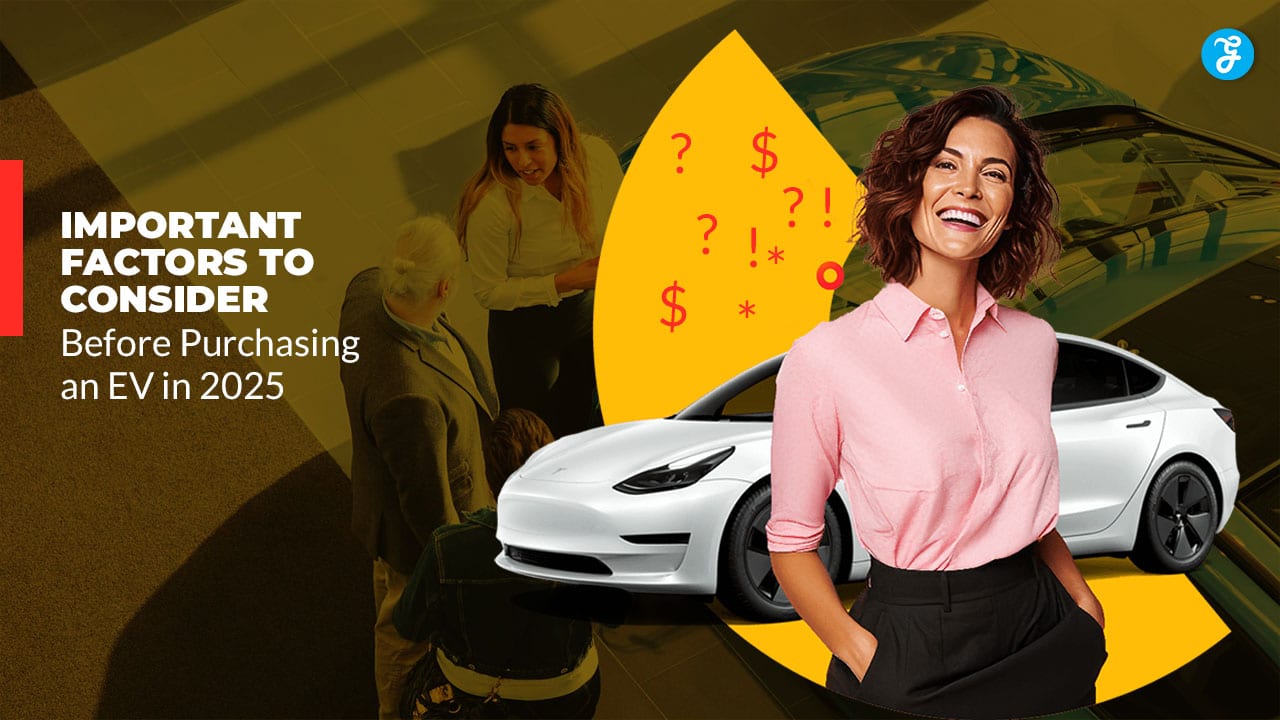The electric vehicle (EV) market has experienced tremendous growth in recent years, with global EV sales surpassing 10 million units in 2022—an increase of over 55% compared to the previous year. Experts predict that EVs will account for nearly 30% of new vehicle sales worldwide by 2030, with 2025 set to be a pivotal year for the industry.
As EV technology advances and environmental awareness rises, more people are considering transitioning from traditional gas-powered cars to EVs. However, purchasing an EV isn’t just about picking the latest model; it requires careful evaluation of several key factors to ensure you’re making a smart investment.
This guide explores seven crucial aspects to consider before buying an electric vehicle in 2025. Whether you’re a first-time EV buyer or looking to upgrade, understanding these factors will help you choose a vehicle that fits your lifestyle, budget, and long-term goals.
1. Battery Life and Range
The battery is the heart of any electric vehicle, making its longevity and range one of the most critical factors to consider. In 2025, EV batteries are expected to deliver improved efficiency, but understanding the range and lifespan remains essential.
Key Considerations:
- Battery Capacity: Look for EVs with higher kilowatt-hour (kWh) ratings, as they generally offer longer ranges.
- Estimated Range: Assess how far the vehicle can travel on a full charge. Many 2025 models are projected to exceed 300 miles per charge, making them suitable for long commutes.
- Factors Affecting Range: Weather conditions, driving habits, and additional loads (like passengers or cargo) can impact range.
- Battery Warranty: Opt for models with robust warranties covering at least eight years or 100,000 miles.
- Advancements in Battery Technology: Recent developments in solid-state batteries promise higher energy densities, faster charging times, and improved safety compared to traditional lithium-ion batteries. These are expected to become more commercially available by 2025, making EVs even more reliable and efficient.
- Battery Recycling Initiatives: Manufacturers are increasingly focusing on recycling programs to recover valuable materials like lithium, nickel, and cobalt. Brands such as Tesla and Redwood Materials are pioneering efforts to make EV batteries more sustainable and cost-effective through recycling.
| Model | Battery Range (Miles) | Warranty |
| Tesla Model Y | 330 | 8 years/120,000 miles |
| Hyundai Ioniq 5 | 303 | 10 years/100,000 miles |
| Chevrolet Bolt EUV | 247 | 8 years/100,000 miles |
2. Charging Infrastructure
The convenience of charging plays a significant role in the EV ownership experience. While home charging is an excellent option for many, public charging networks are vital for long-distance travel and city driving.
Key Considerations:
- Home Charging: Install a Level 2 charger at home for faster charging (typically 4-8 hours for a full charge).
- Public Charging Networks: Ensure access to reliable charging stations through networks like Electrify America or Tesla Superchargers. Use tools like PlugShare or ChargePoint apps to locate nearby charging stations in real-time.
- Fast Charging: Evaluate whether the EV supports fast charging for quick top-ups (e.g., 80% charge in 20-30 minutes).
- Charging Costs: Compare the cost of electricity per kWh in your area with gas prices.
| Charger Type | Charging Speed | Average Cost |
| Level 1 (120V) | 3-5 miles/hour | $0.10-$0.20 per kWh |
| Level 2 (240V) | 20-30 miles/hour | $0.10-$0.20 per kWh |
| DC Fast Charging | 60-80 miles in 20 mins | $0.25-$0.40 per kWh |
3. Total Cost of Ownership (TCO)
While EVs typically have higher upfront costs than gasoline-powered vehicles, their lower operating expenses can result in long-term savings. However, the total cost of ownership can vary significantly by region due to differences in electricity prices, fuel costs, and available incentives.
Key Considerations:
- Upfront Price: EV prices in 2025 range from $25,000 for budget-friendly options to over $100,000 for luxury models.
- Maintenance Costs: EVs have fewer moving parts, which reduces maintenance expenses. No oil changes or engine tune-ups are needed.
- Incentives and Subsidies: Research federal and state-level incentives for EV purchases. Many regions offer tax credits or rebates up to $7,500. In countries like Norway, additional perks such as reduced tolls and free parking are also available.
- Fuel Savings: Charging an EV is generally cheaper than refueling a gas vehicle. In the U.S., electricity costs average $0.13 per kWh, while European countries like Germany may experience higher rates averaging $0.30 per kWh. Despite this, the overall fueling cost remains lower than gasoline, which varies significantly by country and region.
| Cost Component | EV (Low-Cost Region) | EV (High-Cost Region) | Gas Vehicle |
| Annual Maintenance | ~$300 | ~$300 | ~$900 |
| Fuel/Charging Costs | ~$400/year | ~$700/year | ~$1,500/year |
| Tax Incentives | Up to $7,500 | Up to $5,000 | None |
4. Vehicle Performance and Features
EVs are known for their smooth acceleration, quiet operation, and advanced technology features. In 2025, the latest models come with impressive performance and smart capabilities.
Key Considerations:
- Acceleration and Handling: EVs like the Tesla Model S can go from 0 to 60 mph in under 2 seconds.
- Technology: Look for features like autonomous driving, over-the-air software updates, and cutting-edge infotainment systems.
- Interior Comfort: EVs often have more cabin space due to the absence of a transmission tunnel.
| Model | 0-60 mph Time (Seconds) | Key Features |
| Tesla Model S Plaid | 1.99 | Autopilot, Smart Summon |
| Ford Mustang Mach-E | 3.5 | BlueCruise, Wireless Sync |
| Nissan Ariya | 5.1 | ProPILOT Assist, Dual Zone |
5. Brand Reputation and Model Availability
Choosing a reliable brand and a model that fits your needs is essential for a satisfying ownership experience.
Key Considerations:
- Established Brands: Tesla, Nissan, and Hyundai are trusted names in the EV space.
- Emerging Brands: New players like Rivian and Lucid Motors are offering innovative models.
- Availability: Check if the desired model is available in your region and its delivery timeline.
- Customer Reviews: Read user reviews and expert ratings for insights.
6. Environmental Impact
One of the primary reasons for switching to EVs is to reduce environmental impact. However, understanding the broader sustainability factors is essential.
Key Considerations:
- Emission Reductions: EVs produce zero tailpipe emissions, significantly lowering your carbon footprint. Over their lifecycle, EVs generate significantly fewer greenhouse gas emissions than internal combustion engine (ICE) vehicles, even when accounting for battery production and electricity generation.
- Sustainable Manufacturing: Evaluate brands that prioritize eco-friendly production processes, such as using recycled materials or renewable energy in manufacturing plants.
- Battery Recycling: Look for manufacturers with battery recycling programs to reduce waste and recover valuable materials like lithium and cobalt. Brands like Tesla and Nissan are leading in battery recycling initiatives.
| Vehicle Type | Lifecycle Emissions (Metric Tons of CO2) | Key Notes |
| Gasoline-Powered Vehicle | ~57 | Includes fuel combustion emissions. |
| Electric Vehicle (EV) | ~28 | Accounts for battery production. |
7. Insurance and Warranty
Insurance premiums and warranty coverage can significantly affect your overall ownership costs and peace of mind.
Key Considerations:
- Insurance Rates: EV insurance can be slightly higher due to repair costs but varies by model.
- Comprehensive Warranties: Opt for models with long-term coverage for the battery and key components.
- Additional Coverage: Consider gap insurance or extended warranties for added protection.
| Model | Insurance Cost (Annual) | Warranty Coverage |
| Tesla Model 3 | ~$1,200 | 8 years/100,000 miles |
| Kia EV6 | ~$1,100 | 10 years/100,000 miles |
| BMW i4 | ~$1,400 | 8 years/80,000 miles |
Takeaways
Buying an EV in 2025 offers numerous benefits, from lower running costs to a reduced environmental footprint. However, it’s essential to consider battery life, charging infrastructure, total cost of ownership, performance, brand reputation, environmental impact, and insurance to make an informed decision. By carefully evaluating these factors, you can choose an EV that aligns with your needs and lifestyle while contributing to a greener future.
Take the time to research and test-drive models to ensure your chosen EV is the perfect fit. As the EV market evolves, staying informed will help you make a smart and sustainable choice.








































